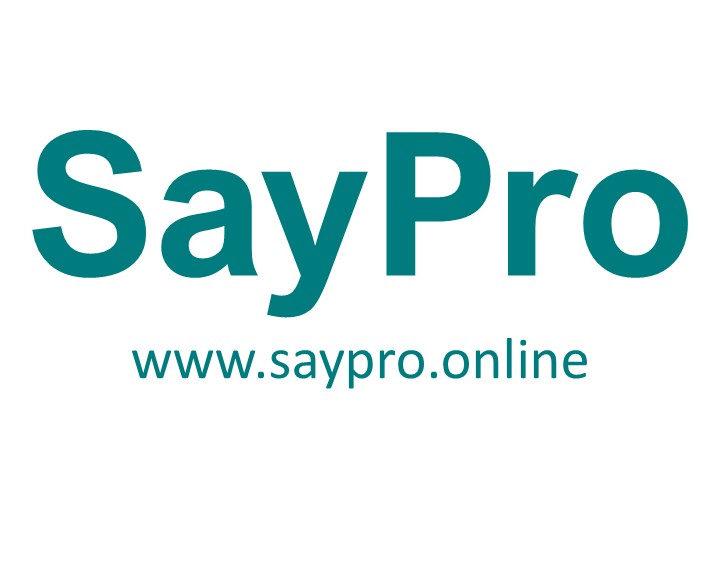SayPro Code: [SCMR-5]
Position: [Marketing Specialist]
Internship/Learnership: [ Intern ]
Full Name: [Likhapha Mpepe]
Date: [12 June 2025]
In Partnership With: SETA/Funder: [MICT SETA]
University/College: [MOTHEO TVET College]
Overview of the Day’s Activities
I worked on ads.saypro.online,
Key Tasks Completed
Task-1 SayPro Market Segmentation Analysis Research Disabled TVET College WIL Intern SayPro116-CCR-1A13
https://en.saypro.online/job/saypro-market-segmentation-analysis-research-disabled-tvet-college-wil-intern-saypro116-ccr-1a13/
Task-SayPro Market Segmentation Analysis Research Disabled Learnership SayPro116-CCR-1A14
https://en.saypro.online/job/saypro-market-segmentation-analysis-research-disabled-learnership-saypro116-ccr-1a14/
Task-3 SayPro Market Segmentation Analysis Research Disabled University Graduate Intern SayPro116-CCR-1A15
https://en.saypro.online/job/saypro-market-segmentation-analysis-research-disabled-university-graduate-intern-saypro116-ccr-1a15/
Task-4 SayPro Market Segmentation Analysis Research Disabled University WIL Intern SayPro116-CCR-1A16
https://en.saypro.online/job/saypro-market-segmentation-analysis-research-disabled-university-wil-intern-saypro116-ccr-1a16/
Task-5 SayPro Saint Mary’s Community Centre
https://ads.saypro.online/index.php/advert/saypro-saint-marys-community-centre/
Task-6 SayPro Myco Multipurpose Centre, Sunnyside
https://ads.saypro.online/wp-admin/post.php?post=344412&action=edit
Task 7 SayPro Mpumalanga Youth Council NPO
https://ads.saypro.online/wp-admin/post.php?post=344411&action=edit
Task 8 SayPro Batho centered institution
https://ads.saypro.online/wp-admin/post.php?post=344410&action=edit
Task 9 SayPro Pure Religion NPC Nelspruit
https://ads.saypro.online/wp-admin/post.php?post=344409&action=edit
Task 10 SayPro Learning Palace Foundation Mookloof
https://ads.saypro.online/wp-admin/post.php?post=344409&action=edit
Task 11 SayPro Pure Religion NPC Nelspruit
https://ads.saypro.online/wp-admin/post.php?post=344407&action=edit
Task 12 SayPro EnviroParks Riverlea
https://ads.saypro.online/wp-admin/post.php?post=344406&action=edit
Task 13 SayPro Letanya Readers
https://ads.saypro.online/wp-admin/post.php?post=344405&action=edit
Task 14 SayPro Phambano Arnold Netshambidi
https://ads.saypro.online/wp-admin/post.php?post=344404&action=edit
Task 15 SayPro Tshepang Programme for Orphanned and Vulnerable Children
https://ads.saypro.online/wp-admin/post.php?post=344403&action=edit
Task 16 SayPro Mikaela Aftercare Centre
https://ads.saypro.online/wp-admin/post.php?post=344402&action=edit
Task 17 SayPro Zenzele counselling Project
https://ads.saypro.online/wp-admin/post.php?post=344401&action=edit
Task 18 SayPro Thiboloha Bophelong HIV and AIDS Project
https://ads.saypro.online/wp-admin/post.php?post=344400&action=edit
Task 19 SayPro Zenzeleni Children’s Village and Agriculture
https://ads.saypro.online/wp-admin/post.php?post=344399&action=edit
Task 20 SayPro Ikhaya le Ndumiso Ministries
https://ads.saypro.online/wp-admin/post.php?post=344398&action=edit
Task 21 SayPro Alexandra Child Care Support Centre
https://ads.saypro.online/wp-admin/post.php?post=344397&action=edit
Task 22 SayPro Dirang ka Kagiso Child and Youth Development Centre
https://ads.saypro.online/wp-admin/post.php?post=344396&action=edit
Task 23 SayPro Orange Farm Child Children’s Home
https://ads.saypro.online/wp-admin/post.php?post=344395&action=edit
Task 24 SayPro Siyabonga Multipurpose
https://ads.saypro.online/wp-admin/post.php?post=344394&action=edit
Task 25 SayPro St Amos Christian Church
https://ads.saypro.online/wp-admin/post.php?post=344393&action=edit
Task 26 Spruitview Assemblies of God
https://ads.saypro.online/wp-admin/post.php?post=344392&action=edit
Task 27 SayPro Bophelong Seventhday Adventist Church
https://ads.saypro.online/wp-admin/post.php?post=344391&action=edit
Task 28 SayPro Built Africa
https://ads.saypro.online/wp-admin/post.php?post=344390&action=edit
Task 29 Pamela Chauke Gauteng Social Development
https://ads.saypro.online/wp-admin/post.php?post=344389&action=edit
Task 30 SayPro Soweto Home Based Care Givers
https://ads.saypro.online/wp-admin/post.php?post=344388&action=edit
Task 31 SayPro Adonai Fellowship Centre
https://ads.saypro.online/wp-admin/post.php?post=344387&action=edit
Task 32 SayPro Baagi Institute of Humanity
https://ads.saypro.online/wp-admin/post.php?post=344386&action=edit
Task 33 SayPro Diakonia AIDS ministry
https://ads.saypro.online/wp-admin/post.php?post=344385&action=edit
Task 34 SayPro Friends for life
https://ads.saypro.online/wp-admin/post.php?post=344384&action=edit
Task 35 SayPro WomansHim
https://ads.saypro.online/wp-admin/post.php?post=344383&action=edit
Task 36 SayPro Grace & Peace
https://ads.saypro.online/wp-admin/post.php?post=344382&action=edit
Task 37 SayPro Tshwane city Parish
https://ads.saypro.online/wp-admin/post.php?post=344381&action=edit
Task 38 SayPro Asibambaneni sibemunye project
https://ads.saypro.online/wp-admin/post.php?post=344380&action=edit
Task 39 SayPro Emthonjeni Satellite
https://ads.saypro.online/wp-admin/post.php?post=344379&action=edit
SayPro Tears foundation
https://ads.saypro.online/wp-admin/post.php?post=344378&action=edit
Support/Assistance Required
Reflection and Personal Growth
I learned how to be a team player
Goals for Tomorrow
Goal 1 – publish more classifieds ads
Goal 2 – finish logbook
Signature:
Intern/Learner Name & Surname: Likhapha Mpepe

